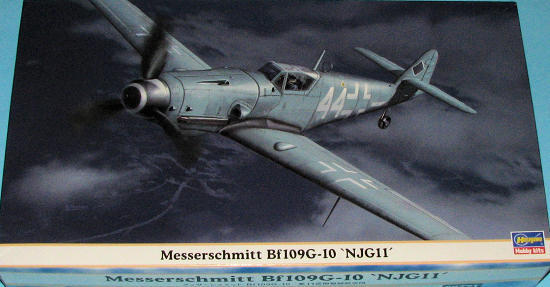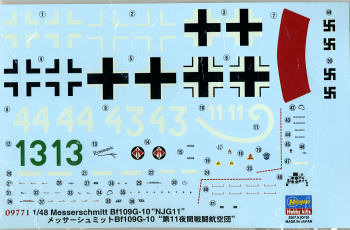
Hasegawa 1/48 Bf-109G-10 'NJG 11'
| KIT: | Hasegawa 1/48 Bf-109G-10 'NJG 11' |
| KIT #: | 09771 |
| PRICE: | $25.15 at GreatModels |
| DECALS: | Three Options |
| REVIEWER: | Scott Van Aken |
| NOTES: | Reboxing with new decals |

| HISTORY |
NJG 11 was established in November of 1944 and based at Berg, near Magdeburg. It mission was dedicated to night interception of RAF Mosquitos operating over the area. Its first commander was Oberleutnant Kurt Welter, an ace of notoriety who was an expert in single-seat night fighting. Operating with no radar, he was able to knock down several Mosquitos and a Lancaster flying the Bf-109G-10. In January, the unit transitioned to the Me-262A. These were flown as standard fighters and Oblt. Welter claimed over 25 Mosquitos and 2 four engined heavies. He ended the war with 63 victories in 93 missions, 56 of them at night.
The Bf-109G-10 was a 'stop-gap' aircraft that was based on the G-6 airframe. It incorporated all of the updates that were to be installed in the Bf-109K-4 except the outer main landing gear doors. Most G-10s had an Erla Haube canopy, wooden tail, and tall tail wheel. There was a mixture of those with the additional wide main wheels with the corresponding wider fairings on the upper wing to allow them to fit and the standard version with the smaller wing fairings. Some G-10s had the shorter tail wheel. All had the newer, more streamlined cowling. This particular kit has the 'Type 100' cowling where the left side cowling to fuselage fairing is curved.
| THE KIT |
Hasegawa's later 109s are the industry standard and those wanting to build an F-K version in 1/48 scale will gravitate towards this kit. It is typical of when Hasegawa first introduced this kit in the early 1990s. One of the sprues, which contains the wing, has been the same since day one and has been designed for the 109F. G-K modelers will need to scribe an additional panel line and open up the circular wheel well openings. Both tasks take a very short amount of time to complete and most of us are quite used to doing this.
The cockpit is quite complete and will satisfy most builders. However, aftermarket sets generally have a bit higher level of detailing that many seek and so if you wish a higher clarity of detailing, get one of those. The 109G-10 has a different cockpit in terms of arrangement and instrument panel when compared to the G-14 and earlier versions so be sure to get the proper set. The kit provides options for the larger or smaller upper wing fairings so one has to determine which version is being built before gluing the wings together. Since the openings for the small fairings will be easily seen in the wheel well, it would be a good ideal to apply filler after fitting the fairings and before gluing the wings.
The G-10 has a wider set of prop blades and a deeper oil cooler than earlier versions. Those have been provided. The new fuselage halves have all the G-10 identifying features like the different cowling, MW-1 tank bulge on the interior and the wider wheels. This night fighter version will require the builder to add another bit of plastic to the outside of the exhaust shield. It is a simple enough modification to make and Hasegawa shows this. The rest is standard Hasegawa 109 with separate flaps and radiator exhaust doors.
 Instructions
provide both Gunze and RLM color information, which is good considering that
Gunze is no longer sending paints to North America. Two of the options are the
II./NJG 11 aircraft as shown on the box art. These are easy to paint as they are
overall RLM 76 with black spinners and a white spiral. Both of these planes have
the smaller upper wing wheel fairings. Not shows are the small sliding Perspex
panels in the left side of the Erla Haube canopy. This will have to be carefully
scribed in place if the builder wants the additional accuracy. The third decal
option is a II./JG 52 plane with a yellow rudder and nose stripe. Underside
color is RLM 76 with the upper color RLM 75 and a mixture of RLM 75 with some
light grey. If choosing this option, I'd recommend some research as that second
color almost sounds like RLM 77. I'd think it should be some sort of green at
this stage of the conflict. Decals look to be quite nice and if like the more
recent Hasegawa efforts should work just like fine aftermarket decals.
Instructions
provide both Gunze and RLM color information, which is good considering that
Gunze is no longer sending paints to North America. Two of the options are the
II./NJG 11 aircraft as shown on the box art. These are easy to paint as they are
overall RLM 76 with black spinners and a white spiral. Both of these planes have
the smaller upper wing wheel fairings. Not shows are the small sliding Perspex
panels in the left side of the Erla Haube canopy. This will have to be carefully
scribed in place if the builder wants the additional accuracy. The third decal
option is a II./JG 52 plane with a yellow rudder and nose stripe. Underside
color is RLM 76 with the upper color RLM 75 and a mixture of RLM 75 with some
light grey. If choosing this option, I'd recommend some research as that second
color almost sounds like RLM 77. I'd think it should be some sort of green at
this stage of the conflict. Decals look to be quite nice and if like the more
recent Hasegawa efforts should work just like fine aftermarket decals.
| CONCLUSIONS |
And so there you have it. Another fine Hasegawa 109 reboxing. Probably more 109 kits have been produced by Hasegawa than any other aircraft type and I'm sure this one will prove to be quite popular.
March 2008
You can find this and many other fine kits and accessories at www.greatmodels.com
If you would like your product reviewed fairly and quickly, please contact me or see other details in the Note to Contributors.